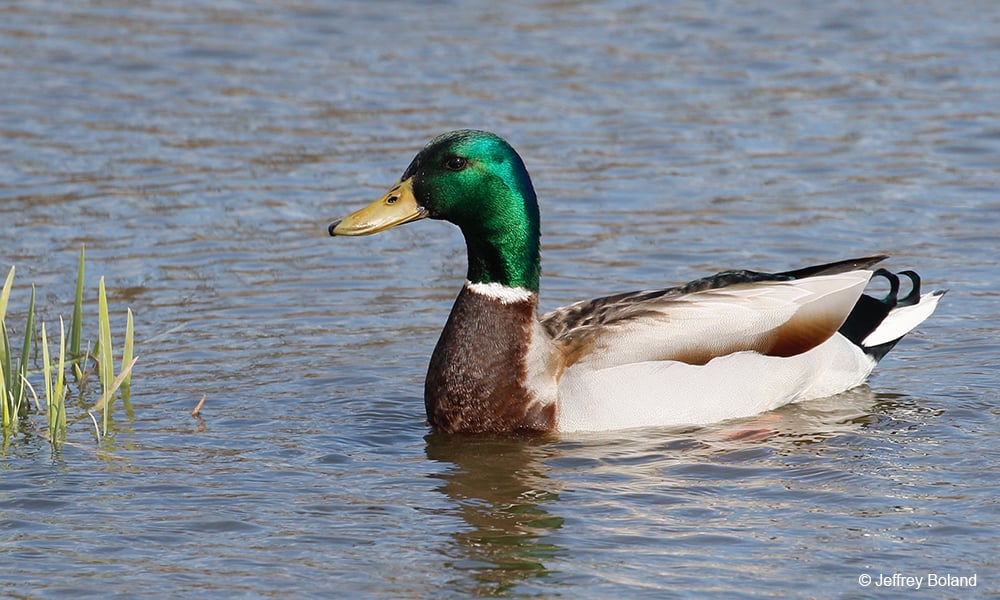
While out birding at Blackwell Forest Preserve the other day, a very curious pair of trail users caught up to me and inquired about all the brown ducks on the water. What species were they? Where were all the mallards?
I raised my binoculars to check the marsh and quickly spotted a family of brown-colored ducks. Then, some more, farther out in the water, dabbling with their tails pointed in the air. Another large family tucked up along the broad-leaved cattails had clambered onto a fallen log, their bright orange feet standing out clear across the marsh.

A mallard family in July. Photo courtesy Jeffrey Boland.
As far as I could tell, all of the usual mallards that had set up breeding territories were still here. No longer, however, did the males don their emerald green heads and silvery body coverings, but rather, they were feathered in brown from head to tail. The inquisitive couple was shocked to hear that those brown ducks were, indeed, mallards! I explained that the male ducks, known as drakes, were in their eclipse plumage.

Female (left) and male mallards in their colorful alternate breeding plumage before their annual molt.
Starting in late June and into July, DuPage County’s breeding duck species – mallard, blue-winged teal, wood duck, and hooded merganser – lose their colorful alternate breeding plumage in place of new flight feathers and body covering feathers in a process called molting.
A really fascinating aspect about ducks is that unlike most molting birds that lose their flight feathers one or two at time, ducks and other waterfowl molt all of their flight feathers in one go. Flightless for three to five weeks, the ducks are vulnerable; however, the drakes are far less conspicuous in their brown garb.

Male mallard in eclipse plumage swimming. Photo courtesy Jeffrey Boland.
At this point in our conversation an immature peregrine falcon flew overhead, its eyes fixed down on the marsh. The immature bird, heavily streaked from chin to belly, had a more brownish-colored back than the slate-blue an adult would sport. The falcon dropped out of the sky toward the water and immediately all of the ducks scurried toward the dense vegetative cover of the cattails and arrowhead plants. Unable to fly, the mallards had no option but to hide.

Immature peregrine falcon. Photo courtesy Mike Warner.
The mallards' brown plumage must have done the trick, though. The young falcon, unable to spot his duck dinner, turned his attention toward a flock of swallows. The frenzied flock, over 130 individuals in number, spun and swirled to avoid the repeated attempts of the falcon to snag one.
The immature tree swallows (much less blue-green than their parents) and the immature barn swallows (much whiter on their undersides and with shorter forked-tails than their parents) flew far more clumsily. Many resorted to diving into the water to avoid the sharp talons of their adversary, a behavior I had never before seen.
After a number of passes back and forth over the marsh, the falcon managed to catch a young barn swallow, a measly snack at best, and went on his way.

Adult (left) and immature barn swallows. Mike Warner.
We finished our conversation on molting, discussing how young birds look rather different than their adult counterparts. Juvenile birds such as swallows and other songbirds molt their tail and flight feathers in the fall, acquiring some “grown-up” feathers. By spring, these young birds will begin to resemble their parents.
I bid the nice couple farewell and turned my attention back toward the marsh. Scanning with my binoculars, I picked out a single pair of wood ducks. Both drake and hen were dull brown. I’m excited to return in October, after the waterfowl have completed their secondary molts, to see these beautiful ducks in full color!
McKee Marsh is a great preserve to see large groups of ducks during waterfowl migration.

A male (left) and female wood duck pair in their alternate breeding plumage. Photo courtesy Jeffrey Boland.